BMW 528I 2000 E39 Central Body Electronics ZKE Manual
Manufacturer: BMW, Model Year: 2000, Model line: 528i, Model: BMW 528i 2000 E39Pages: 80, PDF Size: 4.14 MB
Page 41 of 80
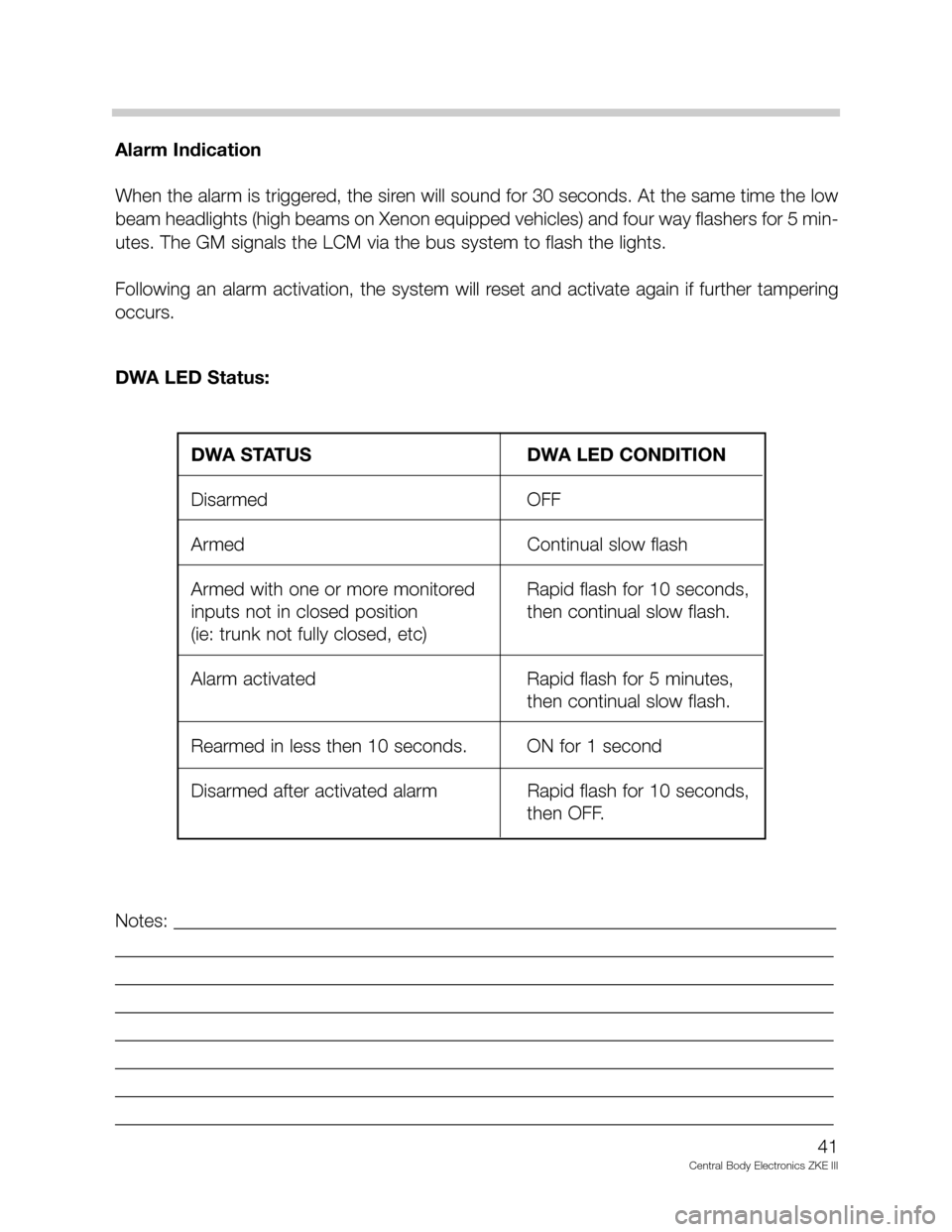
Alarm Indication
When the alarm is triggered, the siren will sound for 30 seconds. At the same time the low
beam headlights (high beams on Xenon equipped vehicles) and four way flashers for 5 min-
utes. The GM signals the LCM via the bus system to flash the lights.
Following an alarm activation, the system will reset and activate again if further tampering
occurs.
DWA LED Status:
Notes: _______________________________________________________________________
_____________________________________________________________________________
_____________________________________________________________________________
_____________________________________________________________________________
_____________________________________________________________________________
_____________________________________________________________________________
_____________________________________________________________________________
_____________________________________________________________________________
41
Central Body Electronics ZKE III
DWA STATUS DWA LED CONDITION
Disarmed OFF
Armed Continual slow flash
Armed with one or more monitored Rapid flash for 10 seconds,
inputs not in closed position then continual slow flash.
(ie: trunk not fully closed, etc)
Alarm activated Rapid flash for 5 minutes,
then continual slow flash.
Rearmed in less then 10 seconds. ON for 1 second
Disarmed after activated alarm Rapid flash for 10 seconds,
then OFF.
Page 42 of 80
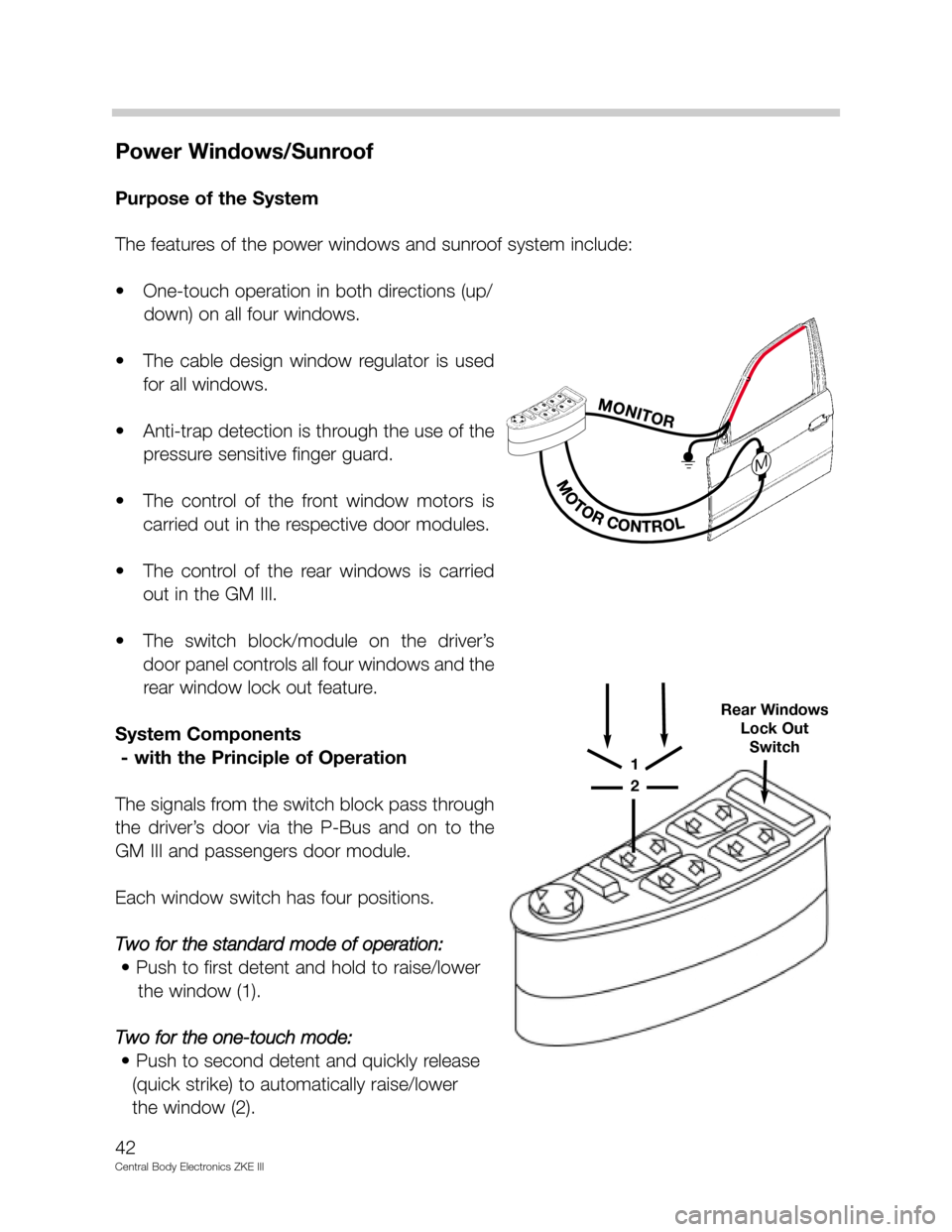
Power Windows/Sunroof
Purpose of the System
The features of the power windows and sunroof system include:
• One-touch operation in both directions (up/
down) on all four windows.
• The cable design window regulator is used
for all windows.
• Anti-trap detection is through the use of the
pressure sensitive finger guard.
• The control of the front window motors is
carried out in the respective door modules.
• The control of the rear windows is carried
out in the GM III.
• The switch block/module on the driver’s
door panel controls all four windows and the
rear window lock out feature.
System Components
- with the Principle of Operation
The signals from the switch block pass through
the driver’s door via the P-Bus and on to the
GM III and passengers door module.
Each window switch has four positions.
Two for the standard mode of operation:
• Push to first detent and hold to raise/lower
the window (1).
Two for the one-touch mode:
• Push to second detent and quickly release
(quick strike) to automatically raise/lower
the window (2).
42
Central Body Electronics ZKE III
1
2
Rear Windows
Lock Out
Switch
Page 43 of 80
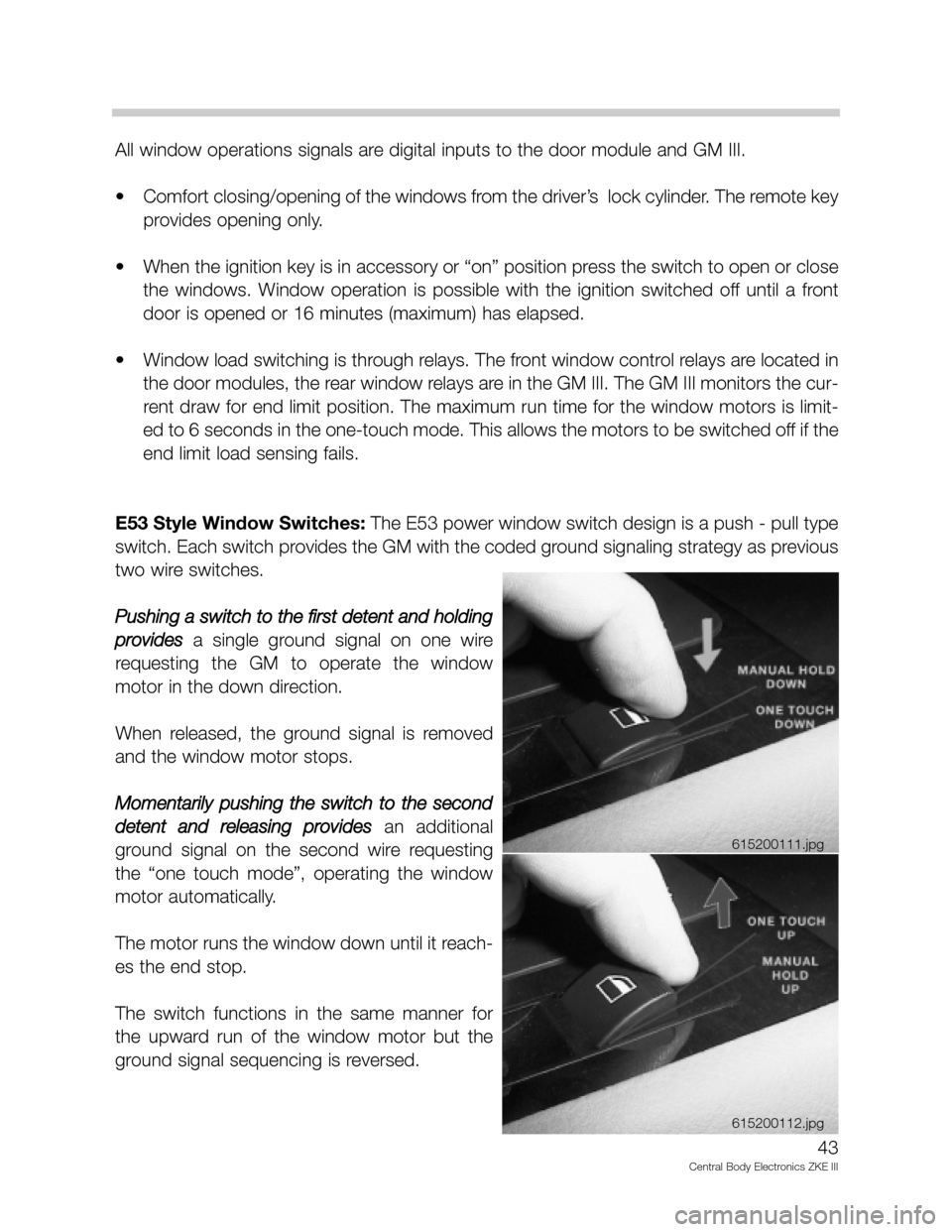
All window operations signals are digital inputs to the door module and GM III.
• Comfort closing/opening of the windows from the driver’s lock cylinder. The remote key
provides opening only.
• When the ignition key is in accessory or “on” position press the switch to open or close
the windows. Window operation is possible with the ignition switched off until a front
door is opened or 16 minutes (maximum) has elapsed.
• Window load switching is through relays. The front window control relays are located in
the door modules, the rear window relays are in the GM III. The GM III monitors the cur-
rent draw for end limit position. The maximum run time for the window motors is limit-
ed to 6 seconds in the one-touch mode. This allows the motors to be switched off if the
end limit load sensing fails.
E53 Style Window Switches:The E53 power window switch design is a push - pull type
switch. Each switch provides the GM with the coded ground signaling strategy as previous
two wire switches.
Pushing a switch to the first detent and holding
provides
a single ground signal on one wire
requesting the GM to operate the window
motor in the down direction.
When released, the ground signal is removed
and the window motor stops.
Momentarily pushing the switch to the second
detent and releasing provides
an additional
ground signal on the second wire requesting
the “one touch mode”, operating the window
motor automatically.
The motor runs the window down until it reach-
es the end stop.
The switch functions in the same manner for
the upward run of the window motor but the
ground signal sequencing is reversed.
43
Central Body Electronics ZKE III
615200111.jpg
615200112.jpg
Page 44 of 80
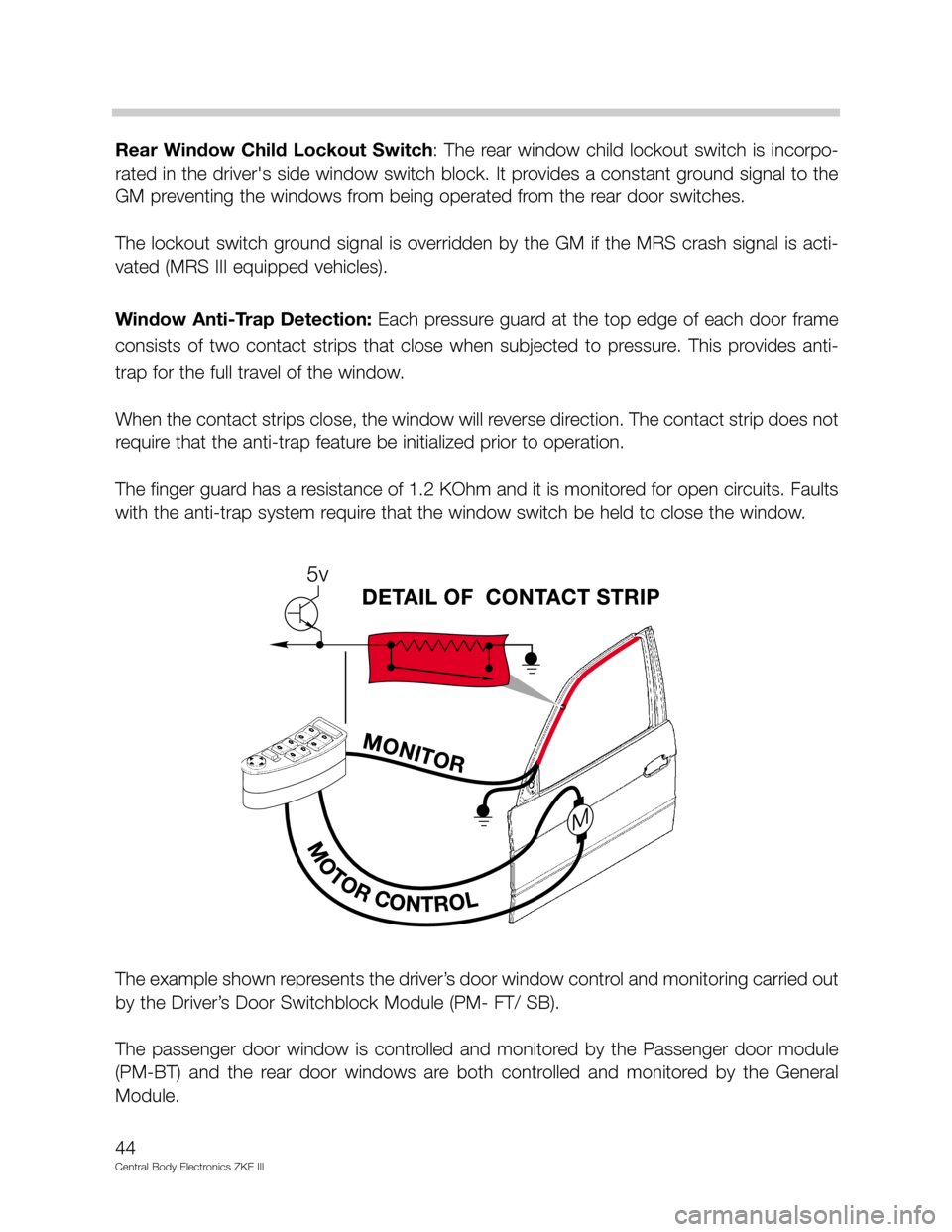
Rear Window Child Lockout Switch: The rear window child lockout switch is incorpo-
rated in the driver's side window switch block. It provides a constant ground signal to the
GM preventing the windows from being operated from the rear door switches.
The lockout switch ground signal is overridden by the GM if the MRS crash signal is acti-
vated (MRS III equipped vehicles).
Window Anti-Trap Detection: Each pressure guard at the top edge of each door frame
consists of two contact strips that close when subjected to pressure. This provides anti-
trap for the full travel of the window.
When the contact strips close, the window will reverse direction. The contact strip does not
require that the anti-trap feature be initialized prior to operation.
The finger guard has a resistance of 1.2 KOhm and it is monitored for open circuits. Faults
with the anti-trap system require that the window switch be held to close the window.
The example shown represents the driver’s door window control and monitoring carried out
by the Driver’s Door Switchblock Module (PM- FT/ SB).
The passenger door window is controlled and monitored by the Passenger door module
(PM-BT) and the rear door windows are both controlled and monitored by the General
Module.
44
Central Body Electronics ZKE III
Page 45 of 80
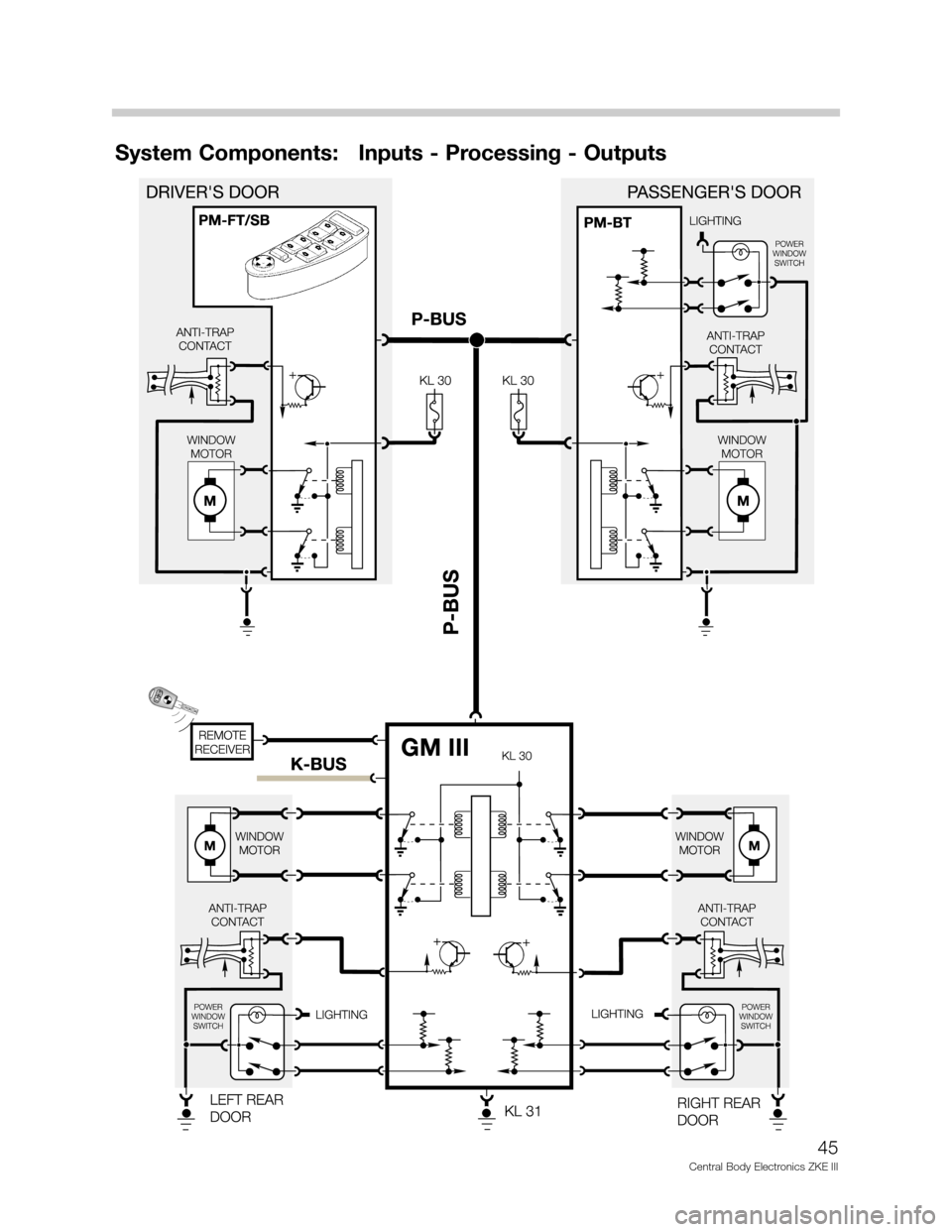
System Components: Inputs - Processing - Outputs
45
Central Body Electronics ZKE III
Page 46 of 80
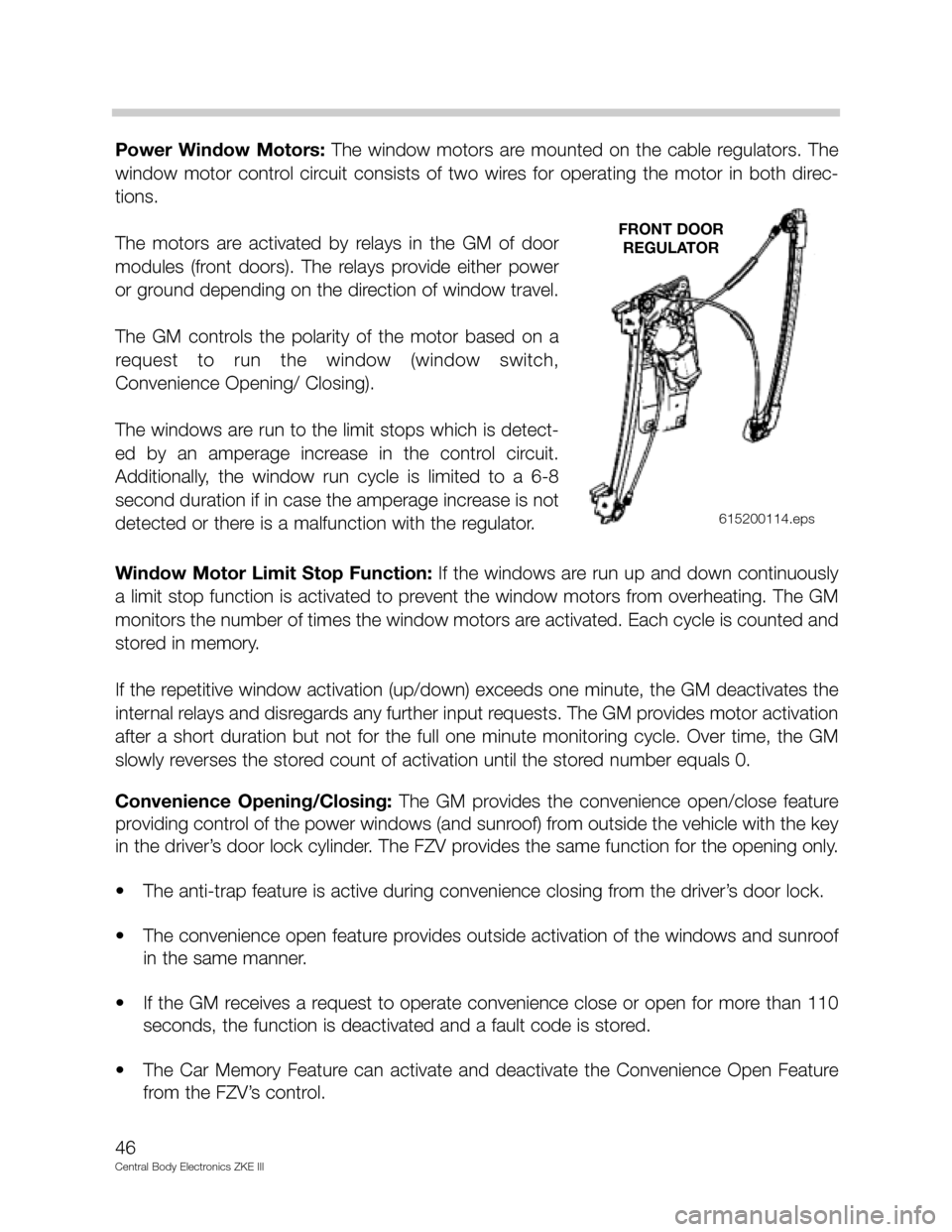
Power Window Motors: The window motors are mounted on the cable regulators. The
window motor control circuit consists of two wires for operating the motor in both direc-
tions.
The motors are activated by relays in the GM of door
modules (front doors). The relays provide either power
or ground depending on the direction of window travel.
The GM controls the polarity of the motor based on a
request to run the window (window switch,
Convenience Opening/ Closing).
The windows are run to the limit stops which is detect-
ed by an amperage increase in the control circuit.
Additionally, the window run cycle is limited to a 6-8
second duration if in case the amperage increase is not
detected or there is a malfunction with the regulator.
Window Motor Limit Stop Function: If the windows are run up and down continuously
a limit stop function is activated to prevent the window motors from overheating. The GM
monitors the number of times the window motors are activated. Each cycle is counted and
stored in memory.
If the repetitive window activation (up/down) exceeds one minute, the GM deactivates the
internal relays and disregards any further input requests. The GM provides motor activation
after a short duration but not for the full one minute monitoring cycle. Over time, the GM
slowly reverses the stored count of activation until the stored number equals 0.
Convenience Opening/Closing: The GM provides the convenience open/close feature
providing control of the power windows (and sunroof) from outside the vehicle with the key
in the driver’s door lock cylinder. The FZV provides the same function for the opening only.
• The anti-trap feature is active during convenience closing from the driver’s door lock.
• The convenience open feature provides outside activation of the windows and sunroof
in the same manner.
• If the GM receives a request to operate convenience close or open for more than 110
seconds, the function is deactivated and a fault code is stored.
• The Car Memory Feature can activate and deactivate the Convenience Open Feature
from the FZV’s control.
46
Central Body Electronics ZKE III
FRONT DOOR
REGULATOR
615200114.eps
Page 47 of 80
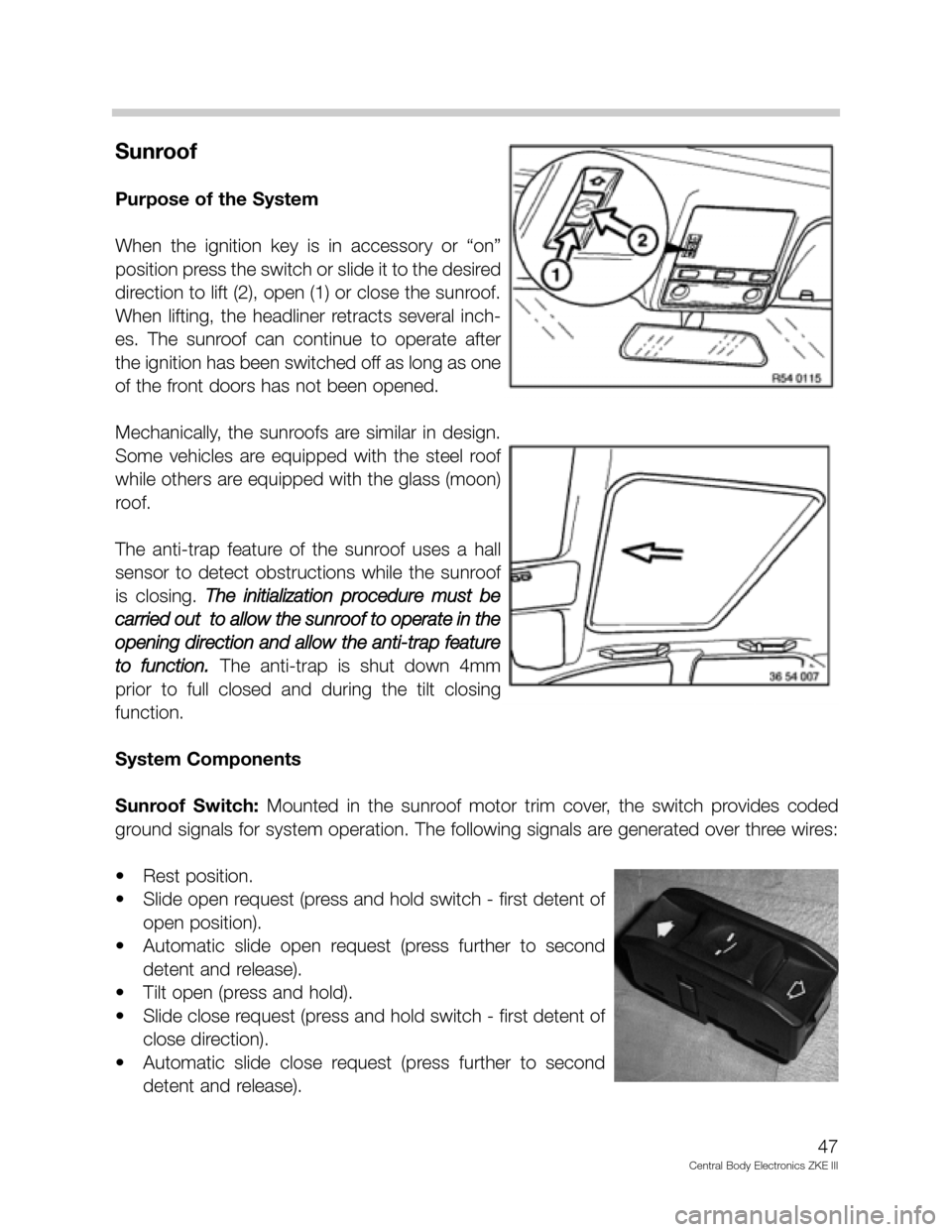
Sunroof
Purpose of the System
When the ignition key is in accessory or “on”
position press the switch or slide it to the desired
direction to lift (2), open (1) or close the sunroof.
When lifting, the headliner retracts several inch-
es. The sunroof can continue to operate after
the ignition has been switched off as long as one
of the front doors has not been opened.
Mechanically, the sunroofs are similar in design.
Some vehicles are equipped with the steel roof
while others are equipped with the glass (moon)
roof.
The anti-trap feature of the sunroof uses a hall
sensor to detect obstructions while the sunroof
is closing. The initialization procedure must be
carried out to allow the sunroof to operate in the
opening direction and allow the anti-trap feature
to function.
The anti-trap is shut down 4mm
prior to full closed and during the tilt closing
function.
System Components
Sunroof Switch:Mounted in the sunroof motor trim cover, the switch provides coded
ground signals for system operation. The following signals are generated over three wires:
• Rest position.
• Slide open request (press and hold switch - first detent of
open position).
• Automatic slide open request (press further to second
detent and release).
• Tilt open (press and hold).
• Slide close request (press and hold switch - first detent of
close direction).
• Automatic slide close request (press further to second
detent and release).
47
Central Body Electronics ZKE III
Page 48 of 80
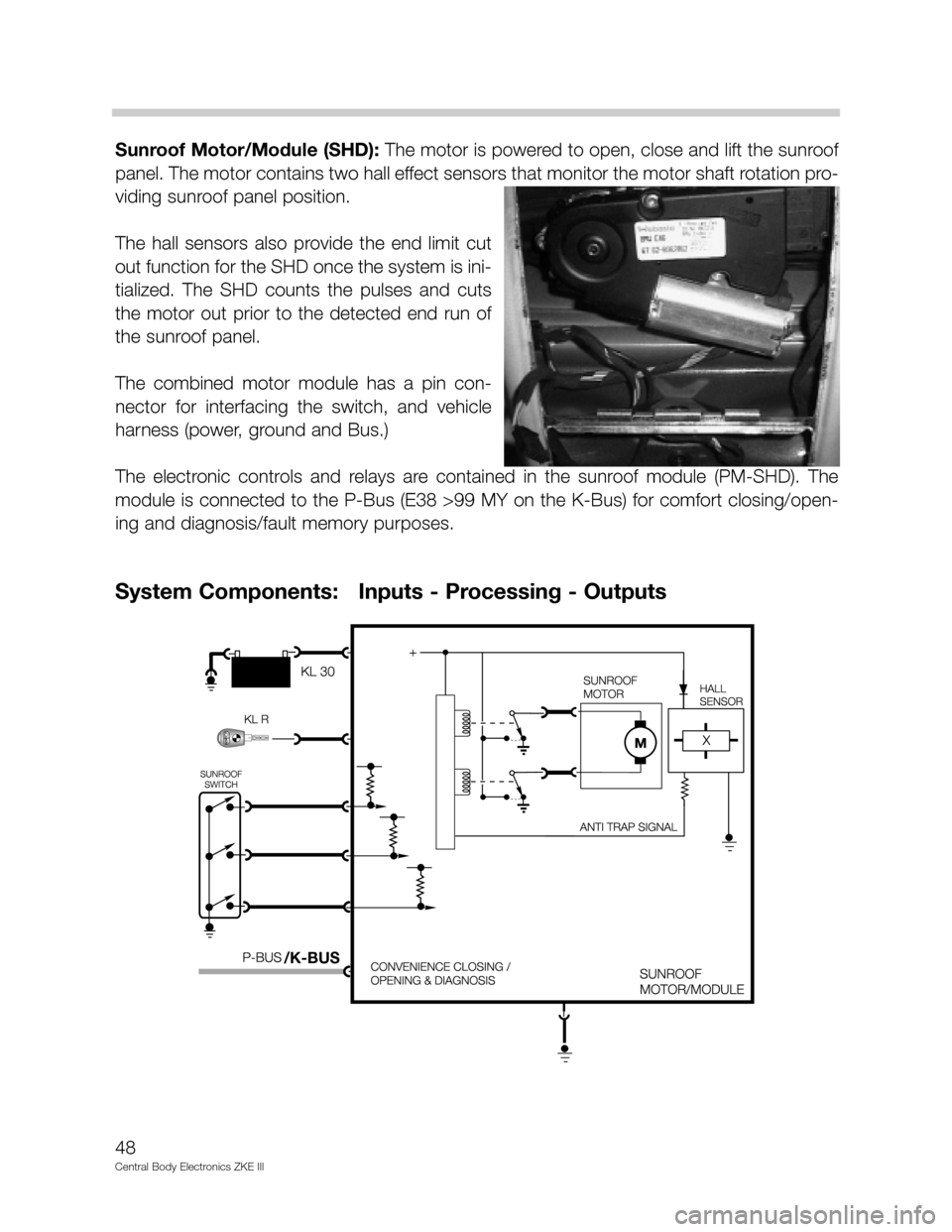
Sunroof Motor/Module (SHD): The motor is powered to open, close and lift the sunroof
panel. The motor contains two hall effect sensors that monitor the motor shaft rotation pro-
viding sunroof panel position.
The hall sensors also provide the end limit cut
out function for the SHD once the system is ini-
tialized. The SHD counts the pulses and cuts
the motor out prior to the detected end run of
the sunroof panel.
The combined motor module has a pin con-
nector for interfacing the switch, and vehicle
harness (power, ground and Bus.)
The electronic controls and relays are contained in the sunroof module (PM-SHD). The
module is connected to the P-Bus (E38 >99 MY on the K-Bus) for comfort closing/open-
ing and diagnosis/fault memory purposes.
48
Central Body Electronics ZKE III
System Components: Inputs - Processing - Outputs
/K-BUS
Page 49 of 80

Principle of Operation
Initialization: Initialization is required for the SHD to learn the end positions of the motor's
travel. The hall sensors provide pulses for motor rotation, the SHD counts the pulses and
determines where the panel is by memorizing the stored pulses.
If the system is not initialized, the sunroof will only operate in the tilt up and slide close posi-
tions. Initialize as follows:
• Press and hold the sunroof switch in either the tilt up or slide close positions for 15 sec-
onds.
• The sunroof motor operates momentarily signifying initialization acceptance.
The SHD memorizes the pulses from the hall sensors on the next activation of the motor
by driving the panel to its end run positions. The SHD senses an amperage increase and
determines the end run position. The counted number of pulses is then used as the basis
for calculating the panel position.
Anti-Trap Feature: The anti-trap feature of the sunroof uses a hall sensor to detect
obstructions while the sunroof is closing (pulse frequency slowed down) in the automatic
close function. The anti-trap feature is shut down prior to full closing (4mm from full closed)
to allow the sunroof to seat into the seal.
Note: The anti-trap feature is not functional when the switch is held in the manual close
position.
Notes: _______________________________________________________________________
_____________________________________________________________________________
_____________________________________________________________________________
_____________________________________________________________________________
_____________________________________________________________________________
_____________________________________________________________________________
_____________________________________________________________________________
_____________________________________________________________________________
_____________________________________________________________________________
_____________________________________________________________________________
_____________________________________________________________________________
_____________________________________________________________________________
49
Central Body Electronics ZKE III
Page 50 of 80
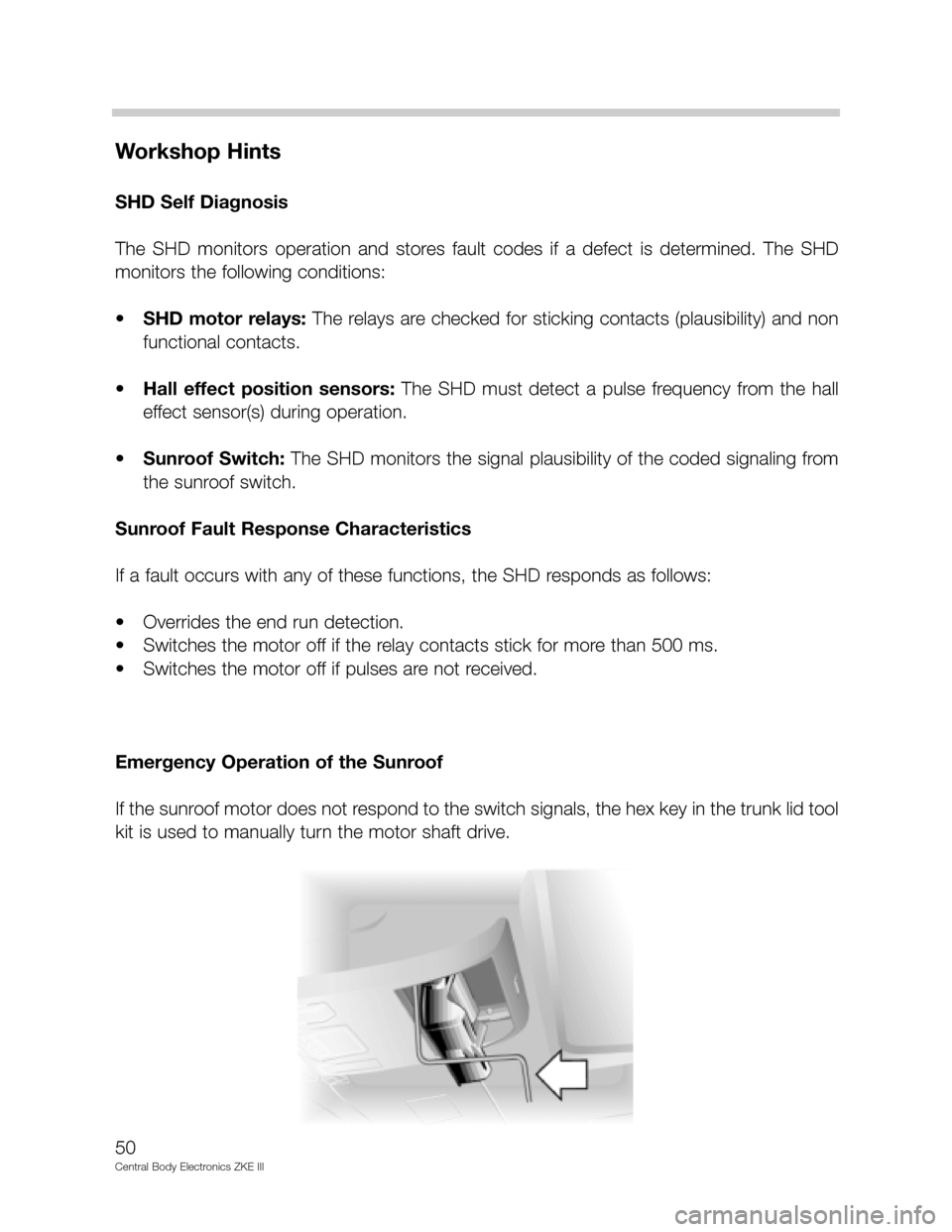
Workshop Hints
SHD Self Diagnosis
The SHD monitors operation and stores fault codes if a defect is determined. The SHD
monitors the following conditions:
• SHD motor relays:The relays are checked for sticking contacts (plausibility) and non
functional contacts.
• Hall effect position sensors:The SHD must detect a pulse frequency from the hall
effect sensor(s) during operation.
• Sunroof Switch: The SHD monitors the signal plausibility of the coded signaling from
the sunroof switch.
Sunroof Fault Response Characteristics
If a fault occurs with any of these functions, the SHD responds as follows:
• Overrides the end run detection.
• Switches the motor off if the relay contacts stick for more than 500 ms.
• Switches the motor off if pulses are not received.
Emergency Operation of the Sunroof
If the sunroof motor does not respond to the switch signals, the hex key in the trunk lid tool
kit is used to manually turn the motor shaft drive.
50
Central Body Electronics ZKE III